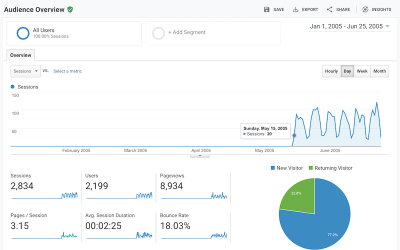
An important series of events for anyone interested in web analytics is Jim Sterne’s eMetrics Summit. There are currently 4 of these per year with the London event held last Thurs and Fri (29/30 March) at the Russell Square Hotel. Unfortunately, due to illness I was unable to attend in person, though Avinash Kaushik stood in for me on the vendor panel and I hear did a great job…
Some questions directed to the vendor panel and from the Google Analytics booth:
- Q: What features differentiate your product from others?
- Quick Answer: Ignore feature lists!
That’s always a good question that regularly comes up. I don’t know other tools in detail, but essentially as far as features go there is very little to differentiate any of the vendors. For example, they all have site overlay, geo-overlay, marketing analysis, eCommerce analysis, x-segmentation etc. Of course there are many ways to skin a cat, but essentially there is a great deal of feature parity out there – so my advice is ignore feature lists!
What is more important if you are selecting a vendor, is to consider what key metrics your organisation needs to know. Look at how easy it is for each vendor to collect and display that information to you. Then how easy is it for you to manipulate it i.e. x-segment, compare against another date range, filter etc.
- Q: Why pay for a service when GA is free?
- Quick Answer: Exactly – invest in understanding the data.
Firstly lets clarify what is meant by GA being free. Google Analytics is a free tool – that’s it. It is a data collection and reporting tool, but it will not analyse or optimise your web site or search engine marketing for you (no tool can!). For that you need intelligent people i.e. expertise. Also some web sites are complicated and require a bespoke implementation. Again that requires expertise.
Some vendors include that expertise as part of their package. The unique approach of Google is it makes its tools as simple as possible to use and understand (I taught myself!) and it has separated the provision of its tool from professional services such as consulting and training.
If you require professional services, buy these separately from independent Google Analytics Authorised Consultants.
- Q: How long does it tale to implement GA?
- Quick Answer: How quickly can you get the tracking code on your pages?
That is always going to depend on how complicated your web site is to track. Similar to search engine optimisation (SEO) principals, web sites can be built that are easy or hard to track – think of the difficulties of Flash only sites. That said, getting initial pageview data is very easy to setup because Google Analytics uses the same page tag (javascript snippet) on every page. So as soon as you can tag your pages, you will start to receive data.
- Q: Can you customise GA reports?
- Quick Answer: At present there is limited customisation of Google Analytics but that will not always be the case…
A key principal of working for Google is what we never discuss future developments – for any product. I can be pain when working in such an exciting fast moving company, but Google likes its ability to surprise its users (and its competition!). All I can say is watch this space…
- Q: In GA can you email reports out?
- Quick Answer: At present no, but that will not always be the case…
Many thanks to Estela Oliver and Philip Walford for helping out on the GA booth.



I wanted to follow up on this post now that the new Google Analytics version is out there. I can now revise the answers to the last 2 questions:
Q: Can you customise GA reports?
The new design has a fully customisable dashboard. A dasboard is a summary area where you can place a chart from the main body of Google Analytics reports. Which reports are on your dashboard can be changed at any time with a maximum of up to 12. When you navigate to a report you will see a ‘Add to dashboard’ link at the top of the page. When viewing the dashboard, simply drag and drop the report into the position you wish.
Q: In GA can you email reports out?
Yep. This was a key feature we really missed in the previous version. Once you have chosen which reports are important to your stakeholders, you will probably wish to have these sent to them via email – either ad hoc or scheduled on a regular basis. To do this, simply chose the Email item next to the export link. Reports can be scheduled to be sent daily, weekly, monthly or quarterly
Yep – fighting fit again. See you in Dusseldorf (second day)
I’m so sorry you couldn’t make it Brian and we’re all hoping that you’re feeling better this week. See you at the next one??
Sorry to hear you were sick. Your evangelist Avinash has written a nice summary of the event on his blog though.